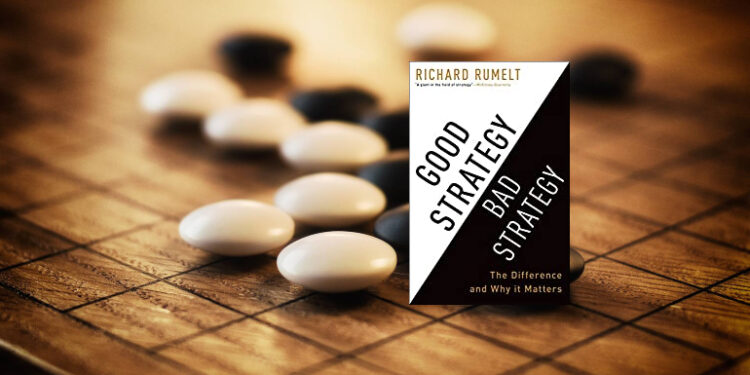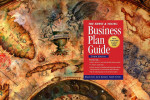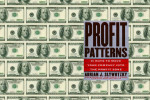Good Strategy, Bad Strategy

Strategy is not goal-setting, vision creation, or agreeing on principles and aspirations. Good strategy means identifying a core, actionable problem that fundamentally affects your current situation and then identifying a set of coordination actions to resolve the challenge.
Bad strategy isn’t the absence of strategy; it’s typically the result of refusing to identify the core problem. If there’s no essential challenge identified, then your strategy is just a set of unrelated aspirations and goals.
Good Strategy Bad Strategy: The Difference and Why It Matters by Richard Rumelt
Product management takeaways: If you’re responsible for developing a strategy for your company, product, or feature, this book will help you create a good strategy rather than a mashup of vision, goals, and mission. With a good strategy, you can overcome the critical issues your product faces.
In Good Strategy, Bad Strategy, Richard Rumelt defines the difference between a strategy and what often masquerades as strategy (e.g., high level concepts, descriptions of future state, and business objectives). Most of the book contains examples of good and bad strategy drawn from business, government, education, and the military. There are an equal number of examples of good and bad strategy to inspire your own thinking.
There’s no easy path to a good strategy, but Rumelt offers some pathways to help get to a good strategy. He points out approaches that have been successfully used by prior strategists to develop good strategies such as promixate objectives, riding the wave of new technologies, and linking together dependent systems.
To create good strategy, start by identifying the problem
A leader’s most important responsibility is identifying the biggest challenges to forward progress and devising a coherent approach to overcoming them.
The hallmark of bad strategy is the absence of a core problem. This gap is often filled with vision, aspirational statements and various descriptions of the future state. If you do not identify the key challenge in your situation, you cannot devise a coordinated and committed response. As a result, you will stay in the same situation.
“Grow by 10% year-over-year” or ” invest in partnerships” are not strategies. There is no actionable problem identified which can the organization can then focus on resolving. Asking the five whys is a good way to find the root cause.
Bad strategy omits the problem
Bad strategy is not the absence of strategy. It’s an active force of mistaken belief in how to think strategically and how to create strategies.
Rumelt spends the first part of the book describing what strategy entails and the varieties of activities which masquerade as strategy. Common mis-conceptions of strategy include “ambition, leadership, ‘vision’, planning or the logic of competition.”
Many times, strategy is confused with inspiration or action, which lends it an emotionally positive feeling. Rumelt stresses that a good strategy is grounded in objective reality and “honestly acknowledges the challenges being faced and provides an approach to overcoming them.” Using a sober assessment of the current situation, “a good strategy focuses and coordinates efforts to achieve a powerful competitive punch or problem-solving effort.”
Bad strategy avoids hard reality and the difficult choices required to change the current situation. Rumelt writes that bad strategy “covers up its failure to guide by embracing the language of broad goals, ambition, vision, and values.” Strategy is not the same as success or ambition.
Bad strategy tends to skip over pesky details such as problems. It ignores the power of choice and focus, trying instead to accommodate a multitude of conflicting demands and interests.
Good strategy is based in action. It’s common to “assume that strategy is a big-picture overall direction, divorced from any specific action.” The danger is that by defining strategy as “broad concepts, thereby leaving out action, creates a wide chasm between ‘strategy’ and ‘implementation.'”
Action is a critical component of strategy. If coherent actions are left out, the strategy cannot achieve its objectives. Rumelt notes that “executives who complain about ‘execution’ problems have usually confused strategy with goal setting.”
Rumelt lists four specific attributes of bad strategy:
- Fluff – meaningless terms and inoperative statements which use high concept to obscure and create the illusion of high level thinking
- Failure to face the challenge – if you cannot define the challenge, it is not possible create a new strategy or improve an existing strategy
- Mistaking goals for strategy – some bad strategies are simply statements of desire rather than coherent plans for overcoming challenges
- Bad strategic objectives – strategic objectives result in bad strategy when they fail to address key issues or when they cannot be implemented
Bad strategy is often phrased as “here’s where we’re going” without “how we’re going to get there” If the nature of the challenge is not defined, Rumelt says “no one can assess whether it’s a good plan or bad plan because no one knows what it’s trying to deal with. You don’t know what the difficulty is.”
Conversely, good strategy is primarily focused energy. Rumelt warns: “don’t disperse your efforts”. Coherent actions are a set of coordinated initiatives which enable maximum energy to be applied to a weakness or opportunity within the current situation.
Good strategy includes a proximate objective–something you can accomplish in the near future. This provides a near-term success to support momentum and learning.
Good strategy contains a diagnosis, guiding policy, and coherent actions
Strategy is about focus
Rumelt calls the essential logical structure of strategy the kernel. The kernel consists of a diagnosis, a guiding policy, and coherent actions.
A good strategist will try to find a diagnosis that suggests “here’s something you can do to change things”
The diagnosis is the foundation of strategy and specifies the essential challenge that will be addressed by the strategy.
The guiding policy is the approach used to address the obstacles identified in the diagnosis. The guiding policy “is like a signpost, marking the direction forward, but not defining the details of the trip.”
Coherent actions are “feasible coordinated policies, resource commitments, and actions designed to carry out the guiding policy.”
Bad strategy is more than just the absence of good strategy. Bad strategy has a life and logic of its own, a false edifice built on mistaken foundations.
Bad strategy actively avoids analyzing obstacles and unpleasant realities of the current state because leaders believe that a positive attitude is all that is required to surmount challenges. It’s common to see leaders mistake goal setting for strategy. Strategy is not visioning; it is problem solving. Frequently leaders will perpetrate bad strategy by avoiding making polarizing choices that offend or anger certain stakeholders. In this case, no choice is made; rather, a solution which attempts to please everyone is used to avoid conflicts.
The most basic idea of strategy is the application of strength against weakness. Or, if you prefer, strength applied to the most promising opportunity.
In addition to taking advantage of typical business strengths (aka competitive advantage, moats), strategy uses two powerful natural sources of strength: a coherent strategy that coordinates policies and actions, and the creation of new strengths based on “subtle shifts in viewpoint”
You know when it’s a bad strategy? When there’s no problem. … It’s all about where we hope to get.
Bad strategies paint a picture of the future but don’t identify the problem to be addressed. This is a compounding problem because no one can evaluate the effectiveness of a strategy if there is no challenge identified.
Good strategy says “no”
Good strategy requires leaders who are willing and able to say no to a wide variety of actions and interest. Strategy is at least as much about what an organization does not do as it is about what it does.
Without facing reality in terms of evaluating the current situation and the wherewithal to make choices, strategy can devolve into a lengthy list of unconnected an incoherent pursuits.
How to create a powerful strategy
- Diagnose the challenge: This is the critical step. For example: “why are 40% of the students in the district dropping out before finishing their diploma?” or “Why is there a debt crisis in Greece?”. Ask the five whys to identify the root cause.
- Make your actions coherent: Focus is the heart of strategy. If you don’t say no and harness all the strength and assets of the organization, your strategy will be less likely to succeed.
- Cultivate insight: Defining a good strategy is not about picking something out of a framework. You really have to do your research and consider all aspects of the situation.
- Create a proximate objective: “The way we get to the future is by doing something now”. “A proximate objective is one we can achieve”.
- Ride the wave: Take advantage of technological trends. For example, Apple rode the desktop to mobile wave; Intel rode the microprocessor wave.
- Chain links matter: “To have excellence you have to have a bunch of things work”. In some cases a set of dependencies must all work together in order to achieve a desired state.
- Expect entropy and inertia: There will be resistance to change. Often the current state is self-reinforcing.






